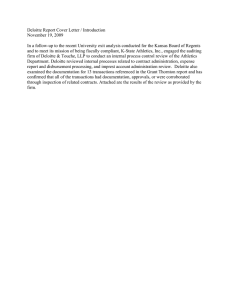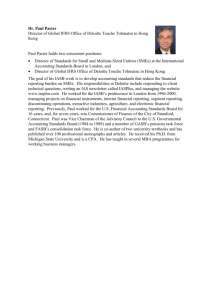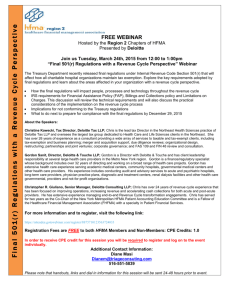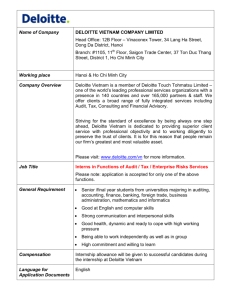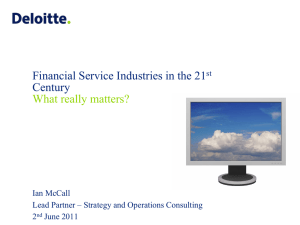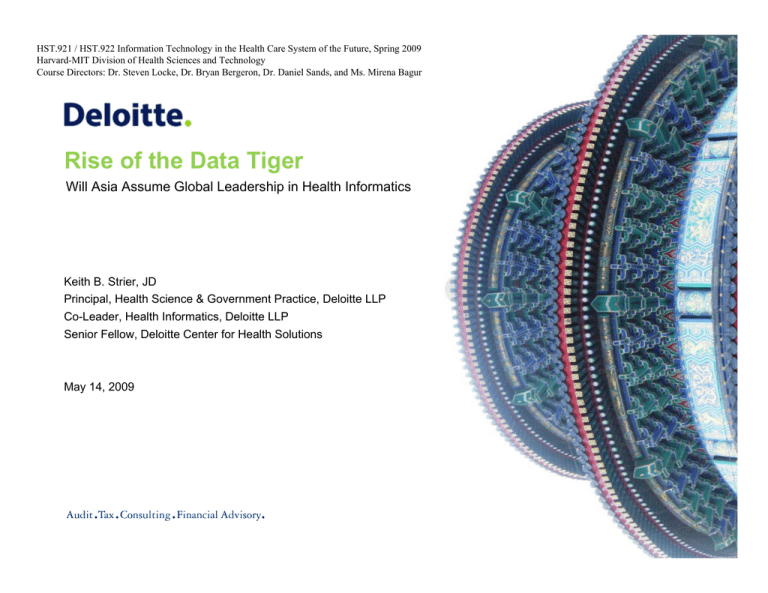
HST.921 / HST.922 Information Technology in the Health Care System of the Future, Spring 2009
Harvard-MIT Division of Health Sciences and Technology
Course Directors: Dr. Steven Locke, Dr. Bryan Bergeron, Dr. Daniel Sands, and Ms. Mirena Bagur
Rise of the Data Tiger
Will Asia Assume Global Leadership in Health Informatics
Keith B. Strier, JD
Principal, Health Science & Government Practice, Deloitte LLP
Co-Leader, Health Informatics, Deloitte LLP
Senior Fellow, Deloitte Center for Health Solutions
May 14, 2009
Definitions
Health informatics is an emerging discipline that focuses on the systematic
management and evaluation of patient-level information - how it is captured, retrieved,
and applied as well as the tools and methods used - to support decision-making along the
continuum from discovery to dissemination.
Role of Informatics from Discovery to Dissemination
Discovery
Informatics
Clinical Research
Informatics
Translational
Informatics
Clinical
Informatics
-2-
Consumer Health
Informatics
Public Health
Informatics
Connective tissue
We are all connected
Aetna
J&J
Peking Union
Medical College
NICE
Patientslikeme.com
Cerner
Kameda
Medical
Center
WHO
And there is no opting out
-3-
Translational Medicine/Research is Ground Zero for Health Informatics
Photo of Affymetrix GeneChip removed
due to copyright restrictions.
Multiple
Uses of
EHR
Data
n
cia
Bench
Clinical Care
ini
Cl
Research Study
Management
Protocol Development
Cohort Identification
Knowledge discovery
Re s
earc
her
Bedside to Bench
Research
Patient Identification
Access to current research
Clinical Decision Support
Evidenced Based Medicine
Patient Safety/Adverse Event
Reporting: protocol deviations
Bedside
Patient
Photo of Mobile Computing C5 system
removed due to copyright restrictions.
Patient/Public Services
Current research/clinical trials
Health education
Bench to Bedside
-4-
Life Sciences Companies are Developing Health Informatics Capabilities
Drug Development
Lifecycle
Improved Clinical Trial Design and
Trial Feasibility through internal
knowledge reuse and mining
external healthcare data
Ensure quality and timely trial
management facilitated by
real-time analysis of trial
management data
Trial Conduct
Planning/Design
Recruitment
Data
Analysis/
Reporting
Submission
Post Marketing
Studies/Risk
Management
Accelerated
eSubmission
process
Accelerate Investigator/Patient
Recruitment process
Mine internal databases/external
healthcare data
Enhanced Data
Visualization/Analysis
Reduce cycle time for data
capture and cleanup
Efficient EDC Approach
Seamless data transfer to
Regulatory Reports
Source: Nigam, J&JDC, 3rd Annual HER & eClinical Technologies Conference
-5-
Efficient Safety Surveillance Process
Efficient Registries/Outcomes studies
Mining external healthcare databases
for real world outcomes
Health Informatics is Exceptionally Global
Canadian Health Authorities
require provincial EHR
systems be standardized
based to enable data
portability
Obama Administration has made
Health IT a showcased feature of its
economic stimulus package
NHS in UK has one of the most
ambitious visions for the EHRs - the
“National Program for Information
Technology (IT)”,
Scotland’s Translational Medicine
Research Collaboration with four
universities and Wyeth focuses
on personalized medicine
Malaysia plans to
have a Lifetime
Health Record (LHR)
by 2010
China has made Health IT
a top priority in its national
health reform program
Japan’s Kameda Medical
Center offers all patients
a fully-portable, digital
health records
National EHR system in
place in Taiwan
National EHR system in
place in New Zealand
-6-
How do we Assess Global Health Informatics Leadership?
Unburdened by the strictures of peer-review or
conflict of interest guidelines, I considered what
unscientific, purely subjective and anecdotal
metrics can be used to benchmark the state of
Health Informatics on a regional basis?
I devised a five-point (im)maturity model:
-7-
Anecdote: UK Earns High Marks for Federal Support and Regulations
Governing Secondary use of Health Data
Image removed due to copyright restrictions.
Website screenshots from NHS Connecting for Health.
http://www.connectingforhealth.nhs.uk/
-8-
Anecdote: Beijing Ministry of Health supports the development of an EMR
for TCM at The People’s Hospital Peking University
-9-
Anecdote: US Companies Lead in Commercialization/Monetization of
Health Data, Chiefly to Big Pharma
SDI Health
General Electric
(logo removed due to copyright restrictions)
(logo removed due to copyright restrictions)
Courtesy of Convergence CT. Used with permission.
- 10 -
Anecdote: Taiwan Stands out for Pervasiveness of Health Data Capture
National Health Insurance Research Database
After the implementation of the National Health Insurance (NHI) in Taiwan in 1995, the Bureau of
National Health Insurance (BNHI) established a national health insurance research database (NHIRD)
to host the claim data of patients who are covered by the universal national health care system. These
patients count for greater than 96% of the total population in Taiwan. There are greater than 95% of
the hospitals contained in this database. Information on all medical treatment undertaken at all medical
institutions that contracted with NHI has been recorded in the database since 1996
Data Source Examples
Strengths
Weaknesses
Longitudinal Health
Insurance Database (2000
& 2005):
The two data sets contain
the registration and claim
data of randomly sampled
patients from 2000 and
2005
• One year of longitudinal information
• Clinical information included
• Accessibility: De-identified data available for
approved research studies
• Diagnoses coded in ICD9
• One year time period
• Sampling data
• Language barrier - diagnoses are coded
using ICD9, but narrative text is Chinese
Inpatient expenditures,
by admission (DD):
Original claim data of
inpatients, by admission.
•
•
•
•
• Language barrier - diagnoses are coded
using ICD9, but narrative text is Chinese
Longitudinal information
Clinical information included
Data is updated regularly
Accessibility: De-identified data available for
approved research studies
• Diagnoses coded in ICD9
- 11 -
Anecdote: Singapore is Registry Happy
Data Source Examples
Strengths
Weaknesses
Singapore Cancer Registry (SCR)
The Singapore Cancer Registry has
been in existence for more than 25
years and its accuracy of data for
incidence, distribution, changing
patterns, etc., is close to 100%
• Complete demographic information
• Data accuracy
• Data access: No direct access for external
organizations
Singapore Childhood Cancer
Registry (SCCR)
It was established in 1997. SCCR data
is also submitted to SCR
• Data accuracy: Contains all children, aged
<=18, diagnosed with haematological or solid
malignancies.
• SCCR also facilitates multi-institutional
clinical trials in the evaluation of treatment
efficacy
• Access: Data is strictly confidential and is
available to all external institutions solely for
research purposes. All data releases are
subjected to the approval of the Medical
Director of SCCR
Renal Registry
It gathers comprehensive data and
statistics on kidney disease from
dialysis centers and hospitals in
Singapore.
• Comprehensive data on
a. Glomerulonephritis
b. End-Stage Renal Disease
c. Transplantation
d. Annual dialysis status reports
• Data access: No direct access for external
organizations
- 12 -
Anecdote: China’s Health Infrastructure is About to Quadruple
Text content removed due to copyright restrictions.
Xiahuo, Cui, and Lan Tian. “China to spend $124b on healthcare reform.”
China Daily, 2009-01-22.
http://www.chinadaily.com.cn/china/2009-01/22/content_7418853.htm.
Accessed 2010-03-02.
- 13 -
Anecdote: There’s at least one company in China trying to commercialize
secondary uses of health data
Courtesy of Yuxi Pacific. Used with permission.
- 14 -
Comparing US and Asia Pacific Health Informatics Leadership
The following countries in the Asia Pacific region were considered:
China and Taiwan
South Korea
Japan
Singapore
Malaysia
Australia
New Zealand
Some conclusions:
Asia-Pacific is a fast growing patient-level data source, but prodigious barriers exist:
HIT adoption varies widely, but “digital hospitals” are on the rise
Most HIT systems are proprietary or home-grown (few international HIT vendors have a
meaningful presence in Asia);
While fears over exploitation of personal health data drives policy, ironically, most residents
lack a cultural appreciation for the personal ownership/control of health information.
In many countries, such as China, Taiwan, Singapore, South Korea, etc. the government
plays a central role in collecting and distributing patient-level data, but regulations are
neither clear nor uniform, which increases the risk of accessing it.
- 15 -
Workshop with the Board of Directors of CHIMA (Chinese Hospital Information
Management Association), the HIMSS of China
- 16 -
Lecture on Health Informatics to Peking Union Medical College Resident Class
- 17 -
Tianjin Tissue Bank Steering Committee Meeting.
- 18 -
Comparing Current Attributes of US and Asia Pacific HI Current State
US
AP
1.
Draw
2.
Leader
2.
Laggard
3.
Leader
3.
Laggard
4.
Leader
4.
Laggard
5.
Draw
1.
5.
- 19 -
Draw
Draw
Thank you for your time
About Deloitte
legal entity operating under the names “Deloitte”, “Deloitte & Touche”,
“Deloitte Touche Tohmatsu” or other related names.
Deloitte refers to one or more of Deloitte Touche Tohmatsu, a Swiss
Verein, its member firms and their respective subsidiaries and
affiliates. Deloitte Touche Tohmatsu is an organization of member
firms around the world devoted to excellence in providing
professional services and advice, focused on client service through a
global strategy executed locally in nearly 140 countries. With access
to the deep intellectual capital of approximately 135,000 people
worldwide, Deloitte delivers services in four professional areas, audit,
tax, consulting and financial advisory services, and serves more than
80 percent of the world’s largest companies, as well as large national
enterprises, public institutions, locally important clients, and
successful, fast-growing global growth companies. Services are not
provided by the Deloitte Touche Tohmatsu Verein and, for regulatory
and other reasons, certain member firms do not provide services in
all four professional areas.
In the United States, Deloitte & Touche USA LLP is the U.S. member
firm of Deloitte Touche Tohmatsu and services are provided by the
subsidiaries of Deloitte & Touche USA LLP (Deloitte & Touche LLP,
Deloitte Consulting LLP, Deloitte Financial Advisory Services LLP,
Deloitte Tax LLP, and their subsidiaries), and not by Deloitte &
Touche USA LLP. The subsidiaries of the U.S. member firm are
among the nation’s leading professional services firms, providing
audit, tax, consulting, and financial advisory services through nearly
40,000 people in more than 90 cities. Known as employers of choice
for innovative human resources programs, they are dedicated to
helping their clients and their people excel. For more information,
please visit the U.S. member firm’s Web site at www.deloitte.com.
As a Swiss Verein (association), neither Deloitte Touche Tohmatsu
nor any of its member firms has any liability for each other’s acts or
omissions. Each of the member firms is a separate and independent
Copyright © 2007 Deloitte Development LLC. All rights reserved.
- 21 -
MIT OpenCourseWare
http://ocw.mit.edu
HST.921 / HST.922 Information Technology in the Health Care System of the Future
Spring 2009
For information about citing these materials or our Terms of Use, visit: http://ocw.mit.edu/terms.

